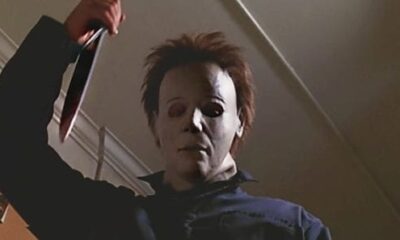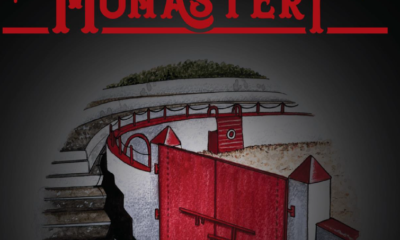
Cycle of the Werewolf VS. Stephen King’s Silver Bullet
There’s quite a few Stephen King movie adaptations that bear little resemblance to the books they’re based on. Stephen King’s Silver Bullet, based loosely on King’s novella The Cycle of the Werewolf, may be one of the more hilariously entertaining deviations from its source material. Whether that was internal or not remains to be seen.
The Cycle of the Werewolf
The Cycle of the Werewolf is unique in King’s repertoire in that it was released as a fully illustrated short novel with each month of the year being a chapter in the story of a werewolf terrorizing the fictional town of Tarker’s Mills, Maine. The chapter format of the book was in part because it was originally supposed to be a calendar, but King found the format too constraining for his storytelling style and it was expanded into a novella.
There aren’t any real main characters in the book. Instead it focuses on the events of the month from the point of view of various townspeople. The plot doesn’t really start until around July and even then it doesn’t bring some relevant characters back together until the last chapter December.
The story itself is a pretty basic werewolf tale with a few notable twists. It’s really illustrator Bernie Wrightson’s gorgeous drawings that help bring the story to life. They complement the story beautifully and can tell the entire story almost on their own.
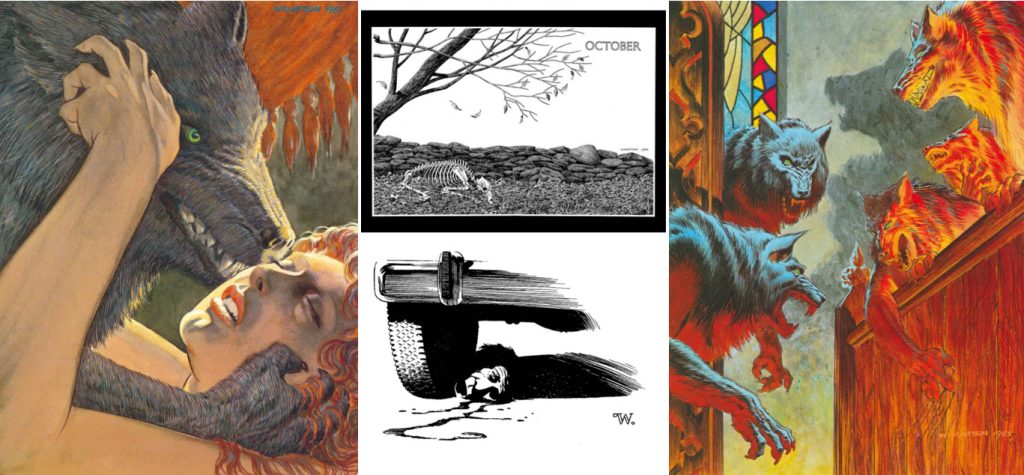
In general, it’s a short but fun little novella that doesn’t break any boundaries but tells a solid gothic horror story nonetheless.
Stephen King’s Silver Bullet (major spoilers here because, boy, do we have a lot to talk about)
The movie adaptation of the book takes almost a 360 in terms of tone and atmosphere from the book. Where the book had an almost grotesque feel to it, the movie goes full out 80s B-movie horror, and to great effect I might add. It’s become something of a cult classic and was the perfect fodder for those pre-teen late night slumber parties huddled up together under your blanket fort.
Our main character is now Marty Coslaw (whose last name I will never get over); a wheelchair bound pre-pubescent who really has a darkly sadistic side, more on that later. Marty’s sister Jane, who didn’t really play much of a part in the book, hates him and constantly calls him a booger for all the things he seems to get away with due to his disability (she’s right by the way). Gary Busey is also there playing basically himself. Seriously, he was allowed to ad lib most of his lines because he related to the character of Uncle Red so much.
.
There are some werewolf kills early on, but the movie mostly forgoes the month to month format entirely and kills off half the town over the course of a few full moons when a vigilante group is formed and decides to go out into the woods at night with no flashlights and zero planning. It ends about as well as you would expect.
One thing that did carry over to the movie from the book is a scene where the town priest, Reverend Lowe, played by Everett McGill, has a dream sequence of his entire congregation turning into werewolves. It kind of lets the cat out of the bag who the werewolf is at that point, but it’s also one of the most memorable scenes in the movie due to the novelty of a whole room full of people just werewolfing out.
It’s around the half point mark in the movie where things start to veer even more wildly from the book. Now you would think the silver bullet in the title of werewolf movie would refer to an actual silver bullet, right? Not in the case of this movie. It’s actually the name of a diesel powered motorcycle wheelchair that Uncle Gary Busey gives Marty on the Fourth of July. That sucker gets up to at least 80mph, can be in no way shape or form street legal, and, as we see later, isn’t very effective against werewolves.
Uncle Gary Busey also gives Marty some fireworks to shoot off once everyone else is asleep since the town’s were canceled due to random werewolf serial killer on the loose, but probably not for COVID if this last year is anything to go by.
Since Marty is such a self-serving little bugger, he of course goes out and shoots off his fireworks and almost gets killed by the werewolf. He only just manages to get away by shooting the werewolf in the eye with a bottle rocket, which is really just unfair when the werewolf doesn’t get any projectiles to defend itself with.
After that mess, Marty recruits his sister to track down his victim under the guise of collecting cans for school (that was an actual thing in the 80s, you just had to be there). In the book Marty gets sent away for the summer and doesn’t run into the werewolf in human form until Halloween. Here it takes them about 12 hours tops to find him. Or more accurately, to find that bat from the picture up above when Jane discovers it in the werewolf’s garage, although where and when she saw the bat before remains a mystery since it was the local bar owner’s.
Marty then proceeds to be a troll and mails the werewolf some seriously bad takes.
Like any good 80s movie, there proceeds a wheelchair car chase scene, after which, Marty somehow convinces his Uncle Gary Busey that his life is in danger (even though he’s the one sending death threat mail) and he needs a real silver bullet to protect himself. After a very odd conversation with a gun dealer about what good presents bullets are for kids, Uncle Gary Busey gets the silver bullet for Marty and stays over to babysit Marty and Jane after sending their parents away on vacation (less witnesses).
The werewolf does show up at Marty’s that night, and very nicely announces himself by busting straight through the wall like the Kool-Aid man.
Remorselessly, Marty grabs the gun and the bullet and shoots the poor creature in its head before it can even begin to explain why it’s there. He and Jane then proceed to reenact that creepy Folgers Coffee Christmas commercial with the brother and sister that are a little too close to each other for comfort. End of movie.
Final Girl Thoughts
Whether or not you consider the movie or the book a classic, or even a cult classic, Cycle of the Werewolf and Stephen King’s Silver Bullet does make for some entertaining camp. It’s interesting to see what’s essentially the same story told in two very different styles. Roger Ebet even called the movie a parody of the book, and while I wouldn’t go quite that far, it definitely deserves an award for stretching the source material to a new limit. 4 out of 5 Cthulhu for an all around good time.
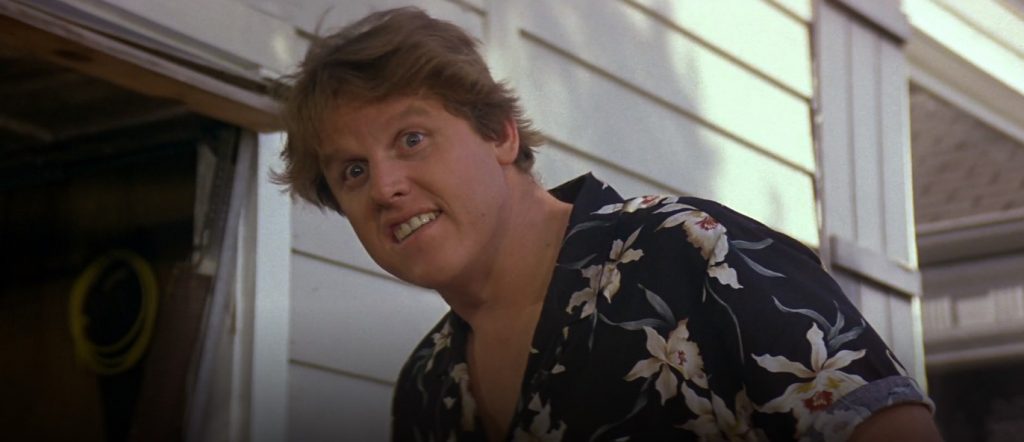
 (4 / 5)
(4 / 5)
Book Reviews
A Stellar Debut Novel, We Used To Live Here
Imagine this. You’re home alone, waiting for your partner to return, when you hear a knock on your door. You answer it to see a family of five, bundled up against the cold. The father, a kindly older gentleman, explains that he used to live in this house as a boy. And he would love to show it to his family.
Do not let them in.
The story
Released in June 2024, We Used To Live Here is author Marcus Kliewer’s debut novel. It tells the story of Eve, who just purchased a beautiful house with her partner, Charlie. Their plan is to flip the house and sell it.
One night, while waiting for Charlie to come home, Eve is surprised by a knock at the door. It’s a man named Thomas Faust and his family.
Thomas explains that he grew up in the house and hasn’t been in the area in years. Would Eve let them in so that he can show the home to his children?
Against her better judgment, Eve lets them in. She regrets this almost at once when Thomas’s daughter vanishes somewhere into the house.
What worked
I always appreciate a book that allows you to play along with the mystery. And this book does that better than just about any other I’ve seen.
Pay close attention to the chapters, to the words that aren’t there. To everything about this novel.
This is mostly down to Kliewer. This is ultimately his work of art. But the production value is also fantastic. I don’t want to ruin the multiple mysteries, so I’ll just say this. There are clues in this book that require some specific artistic choices in the page layouts in this book. And I loved that.
If you’d like to experience another horror book review, check out this one.
We Used To Live Here is also the kind of story that makes you question everything right along with the main character, Eve. Eve is a great main character. But she might be an unreliable narrator. She might be experiencing every single horror described, exactly as it’s described. Or, she might be having a psychotic breakdown. Through most of the book, we can’t be sure. And that is so much fun.
Finally, the weather plays a large part in this story. There are several stories in which the weather or the land itself could be considered a character. Even an antagonist. This is certainly one. The winter storm is the thing that traps the family in the house with Eve. It also makes escaping the home difficult. Reading this book during the winter was especially impactful. Most of us know what it feels like to be shut in by a storm. I’ve personally lived through some of those storms that are just referred to by their year, as though they were impactful enough to claim the whole 365 days for themself. And that was with people I liked. Imagine what it would feel like with strangers. It’s a staggering thought and one that we explore in depth in this book.
- Get Out meets Parasite in this eerily haunting debut and Reddit hit—soon to be a Netflix original movie starring Blake Lively—about two homeowners whose lives are turned upside down when the house’s previous residents unexpectedly visit
- As a young, queer couple who flip houses, Charlie and Eve can’t believe the killer deal they’ve just gotten on an old house in a picturesque neighborhood
- As they’re working in the house one day, there’s a knock on the door
Last update on 2025-03-08 / Affiliate links / Images from Amazon Product Advertising API
In the end, We Used To Live Here is a fantastic book. It’s the sort of story that sneaks into your brain and puts down roots. And if this is just the first book we’re getting from Kliewer, I can’t wait to see what else he comes up with.
 (5 / 5)
(5 / 5)
Book Reviews
Exploring real terror with The House of My Mother
As a disclaimer, this is a review of The House of My Mother from a critical perspective. I will not be discussing my opinions of the legal case against Ruby Franke and Jody Hildebrandt. I will be discussing the merits of the book as a work of true crime alone.
In 2015, Ruby Franke started a YouTube channel called 8 Passengers. In August of 2023, Franke and her business associate Jodi Hildebrandt were arrested for, and later plead guilty to, charges of aggravated child abuse. And in January of this year, Shari Franke told her story in The House of My Mother.
The story
The House of My Mother is the true story of Shari Franke, the oldest child of one of the most famous family vlogger families.
As a child, Shari came to the conclusion that her mother didn’t like her. Soon, she began to fear her mother’s anger.
Things got significantly worse when Ruby started their family vlog. All of the families most intimate moments were splashed across the internet for anyone to watch. This became a living nightmare for Shari.
Of course, that was only the start of the family nightmare. Because Ruby was about to meet someone who would reinforce all of the darkest parts of herself.
Eventually Shari manages to escape her home. But her younger siblings were still in her mother’s clutches. She had to save them, and her father, from the monster her mother had become.
What worked
Through the book, Shari only ever mentions the name of one of her siblings, Chad. This is because Chad is the only of her siblings that is an adult at the time of the publication.
There are children involved in this story. Children who’s lives and privacy have already been damaged. Shari didn’t want to do that to them again, and neither do I.
It probably won’t surprise you that this book is full of upsetting details. But not in the way you might imagine.
Nowhere in this book will you find gory details about the abuse the Franke kids suffered. And I consider that a good thing. Those sort of details are all fun and games when we’re talking fiction. When it’s real kids who are really living with the damage, it’s not a good time.
What you’ll find instead is a slew of more emotionally devastating moments. One that stuck with me is when Ruby’s mother gives her a pair of silk pajamas as a gift after Ruby gave birth to one of her babies. Shari asks Ruby if she’d bring her silk pajamas when she had a baby. Ruby responds that yes, when Shari becomes a mother they can be friends.
What a lovely way to make a little girl feel like she’s not worth anything unless she reproduces. And, if she does decide to have children, who is going to bring her silk pajamas?
- From eldest daughter Shari Franke, the shocking true story behind the viral 8 Passengers family vlog and the hidden abuse she suffered at the hands of her mother, and how, in the face of unimaginable pain, she found freedom and healing
- Shari Franke’s childhood was a constant battle for survival
- Her mother, Ruby Franke, enforced a severe moral code while maintaining a façade of a picture-perfect family for their wildly popular YouTube channel 8 Passengers, which documented the day-to-day life of raising six children for a staggering 2
Last update on 2025-03-02 / Affiliate links / Images from Amazon Product Advertising API
In the end, this isn’t a story about ghosts or demons. It’s not about a serial killer waiting on a playground or in the attic of an unsuspecting family. Instead, this is a story about things that really keep us up at night. It’s the story of a woman so obsessed with perfection that she drove away her eldest daughter. The story of a young woman who’s forced to watch from afar as her beloved brothers and sisters are terrorized and abandoned. These are the sorts of things that really keep us up at night. These are the real nightmares.
More than that, though, The House of My Mother is a story of survival. It’s about a family that was ripped apart and somehow managed to stitch itself back together again. It’s about a brave young woman who managed to keep herself safe and sane in the face of a nightmare. If you haven’t read it yet, I can’t recommend it enough.
For more like this, check out my review of Shiny Happy People.
 (5 / 5)
(5 / 5)
Book Reviews
Book Review of Boreal: an Anthology of Taiga Horror
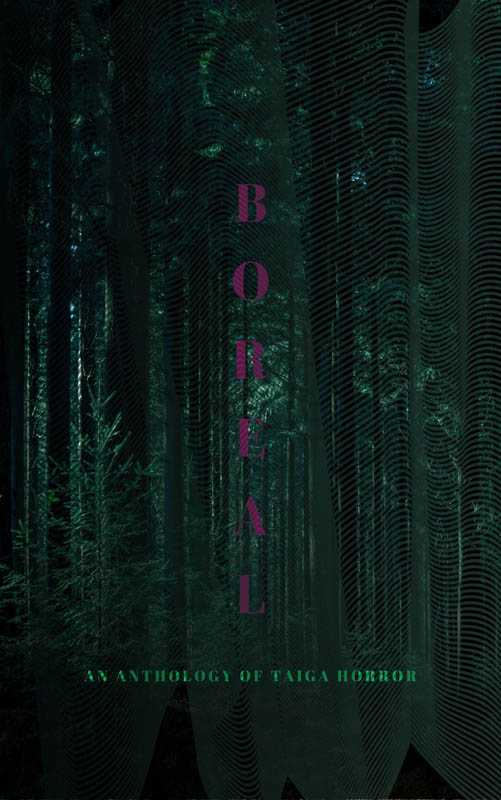
Boreal: an Anthology of Taiga Horror is a collection of twenty-two haunting tales that dwell in the deepest darkest woods and frozen wastelands, edited by Katherine Silva and including Haunted MTL’s very own Daphne Fauber. Each story has even been gifted with its very own poster, hinting at the horrors to be found within it, bestowing a beautiful visual collection as well.
The tales are varied and touch upon the environment in new and different ways, each hearkening to a sort of epiphany or raised awareness. These stories exude both dread and wonder at the smallness of our human existence in contrast to the sacred world we have isolated from, sheltering ourselves in our comfortable houses with centralized heat and everything we could possibly need or want at the ready. The taiga becomes a sanctuary outside of our own dulled awarenesses. It is a holy place imbued with powers beyond mortal human reach, a wilderness that threatens to swallow us – both whole and bit by bit, simultaneously.
The protagonists enter into this realm through ritual, superstition, longing, stubbornness, and their own hubris – yearning to survive its dangers, and to make their own marks upon it. The starkness of their surroundings harbors delicate moments that would be all too easily missed if not deliberately sought or pointed out. The softness of fur, the dappled sunlight shining through trees, the hazy clouds of breath forming in crisp air, the brittleness of bleached bone… those quiet experiences that beg to be forgotten, to lay safely sleeping just below the frozen surface, awaiting spring.
There are those who followed in the footsteps of their predecessors, seeking to escape the constraints of their parent’s and elders’ indoctrination, traditions, madness, and abuse, yearning to find their own way despite also being inextricably bound to their own pasts. There are those who just wanted to go for a walk in the woods, and remained forever changed by what they experienced. There are those who wished to impose their will upon the wilderness, their order falling to disarray, unable to make lasting impact. There are those who sought to leave behind the world of mankind, looking for oneness in the natural order of things through isolation, leaving a bit of themselves behind after being consumed by the terrors they encountered. There are those who truly found communion with the woods, became one with its wildness, and invited its spirit into their hearts to find peace, even at cost of their own lives. And then, there are the spirits themselves…
 (3 / 5)
(3 / 5)
All in all, I give Boreal: an Anthology of Taiga Horror 3.0 Cthulhus. I love existential angst so I found it to be an enjoyable read, and I appreciated the myriad manners in which the biome was explored. But there were points in which I found myself struggling to follow along, as if the words were swept up into their own wilds in ways that alienated myself as reader, as if my mere voyeurism into this otherworldly place was not enough to comprehend the subtle deviations in storytelling mannerisms fully. I suppose in some sense this seems appropriate, but at the same time, it left me feeling a bit unfulfilled, as if I had missed a spiritual connection that should have resonated more deeply.
- English (Publication Language)
- 248 Pages – 02/25/2025 (Publication Date) – Strange Wilds Press (Publisher)
Last update on 2025-01-23 / Affiliate links / Images from Amazon Product Advertising API




